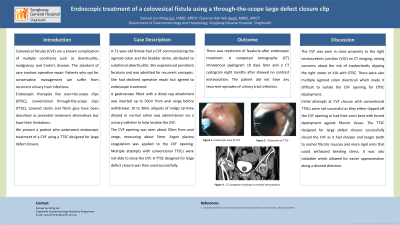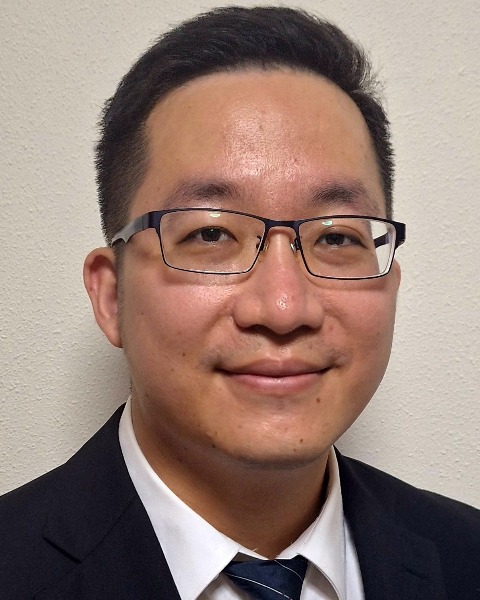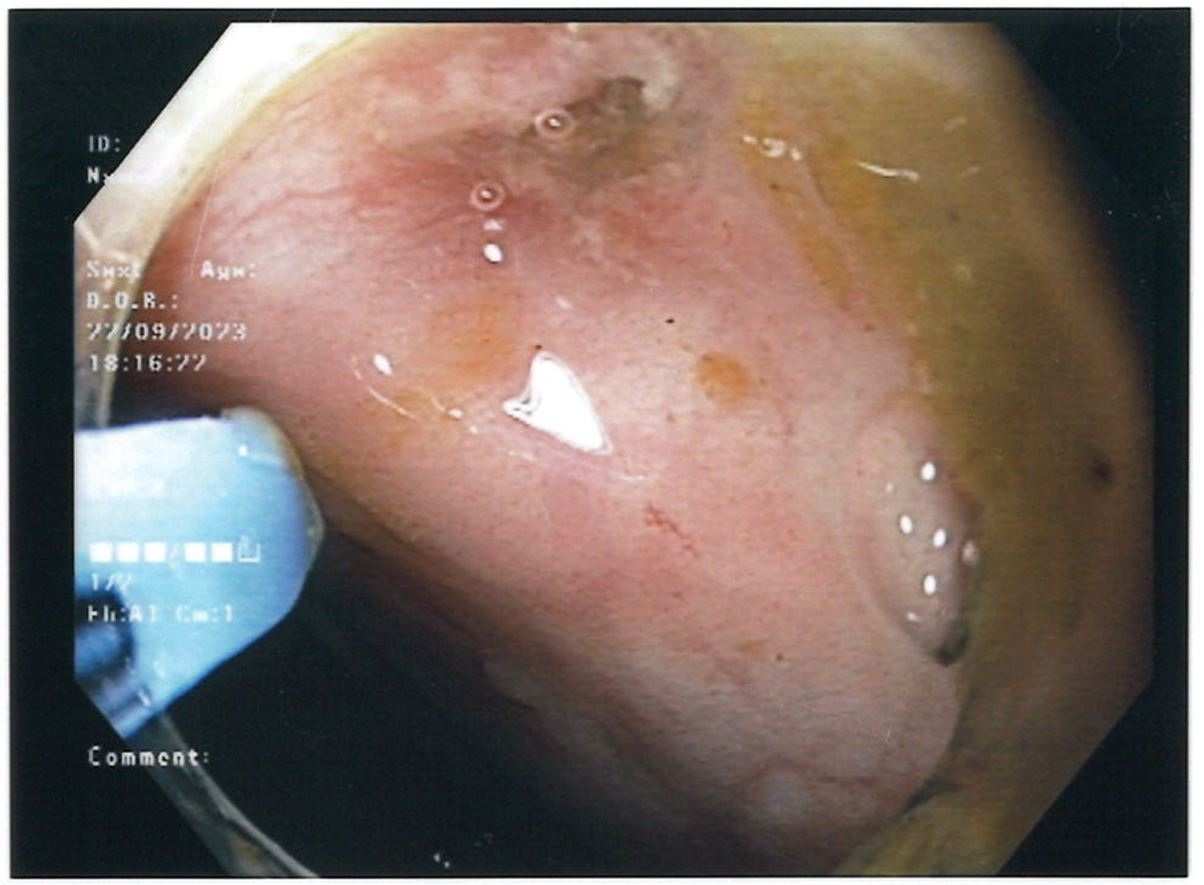Sunday Poster Session
Category: Colon
P0262 - Endoscopic Treatment of a Colovesical Fistula Using a Through-the-Scope Large Defect Closure Clip
Sunday, October 27, 2024
3:30 PM - 7:00 PM ET
Location: Exhibit Hall E

Has Audio

Samuel Jun Ming Lim, MBBS, MRCP
Sengkang General Hospital
Singapore, Singapore
Presenting Author(s)
Samuel Lim, MBBS, MRCP, Clarence Kwan, MBBS, MRCP
Sengkang General Hospital, Singapore, Singapore
Introduction: Colovesical fistulas (CVF) are a known complication of multiple conditions such as diverticulitis, malignancy and Crohn’s disease. The standard of care involves operative repair. Patients who opt for conservative management can suffer from recurrent urinary tract infections. Endoscopic therapies like over-the-scope clips (OTSC), conventional through-the-scope clips (TTSC), covered stents and fibrin glue have been described as potential treatment alternatives but have their limitations. We present a patient who underwent endoscopic treatment of a CVF using a TTSC designed for large defect closure.
Case Description/Methods: A 71-year-old female had a CVF communicating the sigmoid colon and the bladder dome, attributed to subclinical diverticulitis. She experienced persistent fecaluria and was admitted for recurrent urosepsis. She had declined operative repair but agreed to endoscopic treatment.
A gastroscope fitted with a distal cap attachment was inserted up to 50cm from anal verge before withdrawal. 10 to 30mL aliquots of indigo carmine diluted in normal saline was administered via a urinary catheter to help localize the CVF. The CVF opening was seen about 30cm from anal verge, measuring about 5mm. Argon plasma coagulation was applied to the CVF opening. Multiple attempts with conventional TTSCs were not able to close the CVF. A TTSC designed for large defect closure was then used successfully.
There was resolution of fecaluria after endoscopic treatment. A computed tomography (CT) intravenous pyelogram 10 days later and a CT cystogram eight months after showed no contrast extravasation. The patient did not have any recurrent episodes of urinary tract infection.
Discussion: The CVF was seen in close proximity to the right vesicoureteric junction (VUJ) on CT imaging, raising concerns about the risk of inadvertently clipping the right ureter or VUJ with OTSC. There were also multiple sigmoid colon diverticuli which made it difficult to isolate the CVF opening for OTSC deployment.
Initial attempts at CVF closure with conventional TTSCs were not successful as they either slipped off the CVF opening or had their arms bent with forced deployment against fibrotic tissue. The TTSC designed for large defect closure successfully closed the CVF as it had sharper and longer teeth to anchor fibrotic mucosa and more rigid arms that could withstand bending stress. It was also rotatable which allowed for easier approximation along a desired direction.

Disclosures:
Samuel Lim, MBBS, MRCP, Clarence Kwan, MBBS, MRCP. P0262 - Endoscopic Treatment of a Colovesical Fistula Using a Through-the-Scope Large Defect Closure Clip, ACG 2024 Annual Scientific Meeting Abstracts. Philadelphia, PA: American College of Gastroenterology.
Sengkang General Hospital, Singapore, Singapore
Introduction: Colovesical fistulas (CVF) are a known complication of multiple conditions such as diverticulitis, malignancy and Crohn’s disease. The standard of care involves operative repair. Patients who opt for conservative management can suffer from recurrent urinary tract infections. Endoscopic therapies like over-the-scope clips (OTSC), conventional through-the-scope clips (TTSC), covered stents and fibrin glue have been described as potential treatment alternatives but have their limitations. We present a patient who underwent endoscopic treatment of a CVF using a TTSC designed for large defect closure.
Case Description/Methods: A 71-year-old female had a CVF communicating the sigmoid colon and the bladder dome, attributed to subclinical diverticulitis. She experienced persistent fecaluria and was admitted for recurrent urosepsis. She had declined operative repair but agreed to endoscopic treatment.
A gastroscope fitted with a distal cap attachment was inserted up to 50cm from anal verge before withdrawal. 10 to 30mL aliquots of indigo carmine diluted in normal saline was administered via a urinary catheter to help localize the CVF. The CVF opening was seen about 30cm from anal verge, measuring about 5mm. Argon plasma coagulation was applied to the CVF opening. Multiple attempts with conventional TTSCs were not able to close the CVF. A TTSC designed for large defect closure was then used successfully.
There was resolution of fecaluria after endoscopic treatment. A computed tomography (CT) intravenous pyelogram 10 days later and a CT cystogram eight months after showed no contrast extravasation. The patient did not have any recurrent episodes of urinary tract infection.
Discussion: The CVF was seen in close proximity to the right vesicoureteric junction (VUJ) on CT imaging, raising concerns about the risk of inadvertently clipping the right ureter or VUJ with OTSC. There were also multiple sigmoid colon diverticuli which made it difficult to isolate the CVF opening for OTSC deployment.
Initial attempts at CVF closure with conventional TTSCs were not successful as they either slipped off the CVF opening or had their arms bent with forced deployment against fibrotic tissue. The TTSC designed for large defect closure successfully closed the CVF as it had sharper and longer teeth to anchor fibrotic mucosa and more rigid arms that could withstand bending stress. It was also rotatable which allowed for easier approximation along a desired direction.

Figure: Colovesical fistula opening in the sigmoid colon, prior to argon plasma coagulation
Disclosures:
Samuel Lim indicated no relevant financial relationships.
Clarence Kwan indicated no relevant financial relationships.
Samuel Lim, MBBS, MRCP, Clarence Kwan, MBBS, MRCP. P0262 - Endoscopic Treatment of a Colovesical Fistula Using a Through-the-Scope Large Defect Closure Clip, ACG 2024 Annual Scientific Meeting Abstracts. Philadelphia, PA: American College of Gastroenterology.
